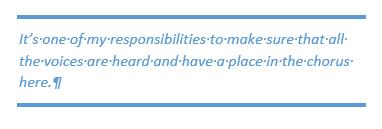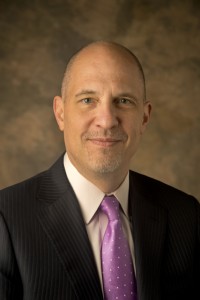Streamlining the Smithsonian
The Smithsonian is a massive organization–the largest museum and research complex in the world. In his first several months on the job, Secretary David Skorton has made several changes to the management structure of the Smithsonian in order to improve efficiency, transparency and collaboration. The Torch recently sat down with Dr. Skorton to talk about these changes and their impact on staff.
The Regents and Congress have approved your plan to restructure and streamline the Smithsonian’s senior management structure. One major change is eliminating the Under Secretary for History, Art, and Culture and the Under Secretary for Science and combining their responsibilities in a single position: Under Secretary for Museums and Research/Provost. Can you tell us why you made this change?
The Smithsonian is such an admirable, creative organization—in the arts, sciences, culture, history, social sciences—but I was surprised to find that our scientific endeavors were under one administrative hierarchy and the non-science areas were under another. In all the academic institutions I’ve ever worked in or been familiar with, academic pursuits, research, scholarship—those kinds of activities all fell together. What are the advantages of doing that? One, it streamlines the administration, as you suggested. Another and probably the most important advantage, is that such a structure formally brings people together to talk about issues.
One of the things I’ve discovered about the Smithsonian is that none of our museums is, strictly speaking, sequestered in one particular area. Is Natural History a science museum? Yes. Is it a history museum? Yes. Is there artistry there? Yes. And there are many other examples. So I think the restructuring is a way of recognizing the holistic nature of the Smithsonian and bringing leaders and creative people together so that they will formally be charged to interact with each other.
In any organization, people tend to work in “silos” because they’re so focused on their own area of expertise. Will this change in organizational structure help promote more collaboration across units?
I think the Smithsonian is a very positive organization. The people I’ve interacted with so far—many, many people, hundreds of people──are proud to work here, really happy with what they do, and proud of the meaningfulness of their work. I think these so-called “silos” have developed not just here but in many organizations based on good and reasonable reasons──because there were people with a similar mission working together, people with similar expertise working together, people who were focusing on contemporary art at the Hirshhorn or people focused on the history and knowledge related to aerospace at NASM, and so on. It was, and is, reasonable to focus effort in any organization in relevant disciplinary areas.
 You’re asking a very hard question──How do you maintain the excellence that comes from focus like this without units becoming competitive with each other while also preventing redundancy of effort and redundancy of expense? I think there are ways to accomplish these goals that are worth a try at the Smithsonian. One way is to gather all the research and museum units under one organizational umbrella, the Provost, so that interaction and communication is fostered at an organizational level. It’s also important to allow people to see the benefits of collaboration. For example, if there’s a thorny problem that we’re dealing with—it could be a procedural problem within the Institution, it could be an external issue, such as when the recession started and many nonprofit organizations had to get by with less revenue──whatever the issue, I’ve found that bringing people together across units or “silos” tends to produce a better solution. I think that if people feel they are part of the deliberation that leads to a change in direction or a solution to a problem, it’s motivating and affirming and encourages people to reach beyond their own unit.
You’re asking a very hard question──How do you maintain the excellence that comes from focus like this without units becoming competitive with each other while also preventing redundancy of effort and redundancy of expense? I think there are ways to accomplish these goals that are worth a try at the Smithsonian. One way is to gather all the research and museum units under one organizational umbrella, the Provost, so that interaction and communication is fostered at an organizational level. It’s also important to allow people to see the benefits of collaboration. For example, if there’s a thorny problem that we’re dealing with—it could be a procedural problem within the Institution, it could be an external issue, such as when the recession started and many nonprofit organizations had to get by with less revenue──whatever the issue, I’ve found that bringing people together across units or “silos” tends to produce a better solution. I think that if people feel they are part of the deliberation that leads to a change in direction or a solution to a problem, it’s motivating and affirming and encourages people to reach beyond their own unit.
Sometimes, there can be monetary incentives. For example, Secretary Clough established “seed grants” that provided funds for cross-unit projects. So, there are many ways to encourage collaboration. What I’ve found very interesting at the Smithsonian (and it’s only been seven months, so I still have a lot to learn), is that there is real interest from people working in many different areas to reach out and understand what their colleagues are doing. I saw a good example of this interest at the Secretary’s Research Awards where there was a good turnout from staff to learn about their colleagues’ projects involving everything from astrophysics to yoga.
When people think of the Smithsonian, they often think only of the Mall museums. Will this new structure help raise the profile of our smaller units?
I see our new streamlined organization—the same structure that’s used in academic institutions—as a way of doing just that. It brings every unit under the oversight of a Provost responsible for both museums and research. There are no longer separate, independent hierarchies—Under Secretary for X, Under Secretary for Y. I am also spending more time personally with the museum and center directors to reinforce this collaborative approach.
Now this doesn’t necessarily solve the problem that occurs no matter what the infrastructure or superstructure of an organization: Smaller units with smaller budgets are sometimes perceived to have less external impact and can get less internal attention at times. It’s one of my responsibilities to make sure that all the voices are heard and have a place in the chorus here.
The Smithsonian has unique challenges in that we are quasi-federal, but also must be partially self-funded through both philanthropy and business interests. Under the reorganization, our business unit, Smithsonian Enterprises, which is responsible for Smithsonian magazine, the Smithsonian Channel and many other revenue-generating ventures, will report to the Under Secretary of Finance and Administration. It makes sense to consolidate revenue generation under one umbrella, but how do we balance any perceived conflict of interest between making money and creating content?
It’s understandable that people would be concerned about that happening, but it is our responsibility—all of our responsibilities, mine, every center or museum director, every single creative person as well as the leadership of Smithsonian Enterprises, to make sure that doesn’t happen. Because if that firewall is breached, if fiscal considerations affect creative decisions, then the whole structure begins to fold. I feel confident through my interactions with Chris Liedel and other leaders of SE, Under Secretary Al Horvath, Acting Provost Richard Kurin and with the museum directors, that everybody’s going in the same direction. We will, from time to time, maybe disagree on a particular issue or the details of an issue, but no one at the Smithsonian will ever compromise on integrity.
Is there anything else you’d like to share with staff?
I really appreciate the warmth with which everyone as welcomed Robin and me and the amount of input I’ve had from people throughout the Institution. Obviously, I get a lot of feedback from directors and senior staff, but I’m also hearing from individuals──A lot of emails, a lot of good comments in town hall meetings. I want to thank everyone for helping me along my learning curve the past few months. I want to redouble my invitation for people to let me know what they’re thinking. Email me at skortond@si.edu. Because I stumble through my inbox myself, it may take me a while to respond, so please be patient. But if you have ideas, concerns or questions, I’d like to hear them.
Check out the new organizational structure (downloadable .pdf file): New SI org chart
Posted: 25 February 2016
-
Categories:
Administrative News , Art and Design , Collaboration , Feature Stories , History and Culture , News & Announcements , Science and Nature






